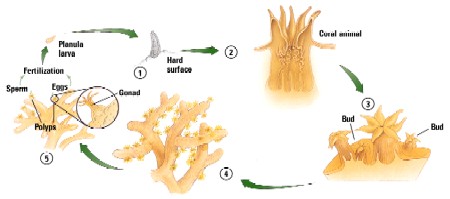Corals can employ two strategies when they need to reproduce:
the sexual and asexual pathway. In a coral colony the individual polyp may use
both strategies in the cause of its lifespan.
|
The reproductive cells of the corals are borne on
membranes that extend inward from the stomach cavity(mesenteries). Sexual
reproduction occurs as either internal or external reproduction. |
|
Internal fertilization results in a zygote that is brooded
within the coral afterwards it is released to the water column as a
free-swimming larvae.
External fertilization occurs when corals release sperm
and eggs to the water in a mass spawning event. The result of external
fertilization is once again a free-swimming larvae that develop from the
fertilized egg. In both cases the free-swimming larvae settle onto a
suited substrate and develop a new coral colony.
|
 |
| 1.
Settled larvae, 2 The living coral animal, 3 reproduction by budding, 4
sexually fertile coral, 5 Egg and sperm releasing tissue and the following
fertilization. |
| Mass spawning occurs when a
large number of corals release sperm and eggs into the water column at the
same time. The release of gametes is usually coupled to the occurrence of
some external factor(time of year, water temperature, lunar and tidal
cycles). This spawning method have both advantages and disadvantages.
First the fertilization in the water column results in a large dispersal
of the eggs. On the other hand a large number of gametes will be lost
because fertilization occur in a very large volume of water. |

